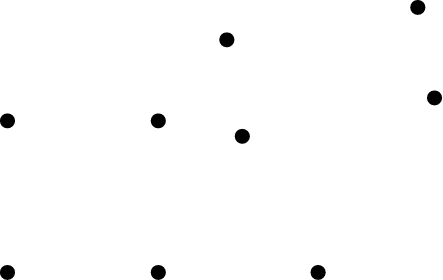| << Chapter < Page | Chapter >> Page > |
1.
a) Yes
b) Yes
c) Yes
1. Why don’t we start by revising a bit? Get your thinking caps on!
a) Are KL and MN parallel?

b) Is OP equidistant from QR?

c) Are the following three line segments equally spaced from each other?

1.4 Use the dots as corners and draw an equilateral triangle, a square and a rectangle.

1.5 Join the dots together so that you will form a parallelogram and a rhombus.

1.6 Use the dots as corners and draw:
a) two triangles of the same shape and size
b) an equilateral triangle
c) a right-angled triangle
(You must use all the dots and you may use each dot only once).

1.7 Draw in all the diagonals of this regular pentagon. Then colour in the only polygon that has been formed.

2. See if you can draw the following (use your protractor and ruler):
2.1 Draw a pentagon where each side is 50 mm long and each corner angle is 108 degrees.
2.2 Draw an octagon where each side is 40 mm long and each corner angle is 135 degrees.
Learning Outcome 3: The learner will be able to describe and represent characteristics and relationships between two-dimensional shapes and three-dimensional objects in a variety of orientations and positions.
Assessment Standard 3.3: We know this when the learner uses a pair of compasses, ruler and protractor to accurately construct geometric figures for investigation of own property and design of nets.
Assessment Standard 3.7: We know this when the learner draws and interprets sketches of solids from different perspectives.

Notification Switch
Would you like to follow the 'Mathematics grade 7' conversation and receive update notifications?